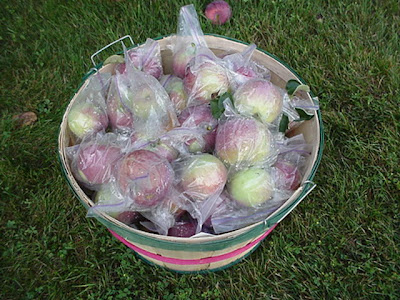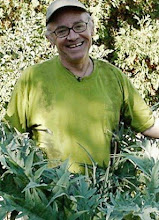 Last year's parsley is going to seed but some Black Swallowtail caterpillars have taken up residence so the plants will get to stay as their home - share for beauties sake.
Last year's parsley is going to seed but some Black Swallowtail caterpillars have taken up residence so the plants will get to stay as their home - share for beauties sake. The greenhouse cucumber is off and growing nicely.
The greenhouse cucumber is off and growing nicely. This is the newly mulched tomato patch.
This is the newly mulched tomato patch. The twine that the plants are trained on is the best material and it composts easily too.
The twine that the plants are trained on is the best material and it composts easily too. Down on the floor of the greenhouse whats left of the grafts are struggling.
Down on the floor of the greenhouse whats left of the grafts are struggling. Garlic flower stalks are curled and need to be cut to allow the garlic to make large heads.
Garlic flower stalks are curled and need to be cut to allow the garlic to make large heads. But these are the first harvest of your crop so put them to good use.
But these are the first harvest of your crop so put them to good use.The rain finally quit after Wednesday to allow for a bit of drying out. The tomato patch was finally dry enough for me to put the straw mulch down between the rows. Tomatoes are best grown with a nice deep mulch that keeps them with constant moisture which will best of all eliminate the dreaded black spot. Yes, calcium is important but even if you add calcium, which you really don't need to do, if the plants go through water stress you will get blossom end rot. Mulch, however, is the key to eliminating this problem. Keep your plants evenly watered and mulched and tomatoes will be happy in your garden. The same is true for potted tomato plants. Keep the pots cool by covering them or putting other pots in front of them to keep the soil temperature low. Potted plants usually need to be watered twice a day morning and evening and in real hot weather maybe even more. As soon as you stress potted tomatoes you will develop those black spots on the underside of your fruits - its the lack of water getting to the cells of the fruit with the suspended calcium in it. So mulch and water are your friends for your tomato crops.
The garlic is making flowers so its time to cut those off. They are edible and I cooked some tonight mixed with onions to garnish our hot dogs - yum yum. Garlic flower shoots store well so you can cut them, put them in a plastic bag and into the vegetable bin in the refrigerator for at least 2 week of use. Mince some into your scrambled eggs. You can cut them off and toss them but they are your first garlic harvest from your growing crop so why not eat them.
I am still working on bagging the apples. I want to get that job done before the coddling moths start laying eggs at the ends of the fruits. Looks like I will be at it now that the tomatoes are done.
The pole beans have sprouted and will need to be planted this week. I plant them all in peat pots because then I can place them at the bottoms of the poles and know that they will start to climb right away. I planted two kinds but the white variety germinated poorly - variety Helda. The brown variety, Fortex, sprouted much better. This week I will clean off the poles, set them out and plant the bean plants around them and hope this year we do not have another ground hog incident. I have seen immature ground hogs that soon will be out on their own looking for territory to move into - not my garden, I hope.
I did some vegetable grafting last week and I find this to be a VERY challenging process. The tomatoes grew together but they have declined again about the time I want to introduce them to more light. The cubits are even more difficulty so I think I need more information and some better directions; plus I might have to build a real mist chamber to get this to happen. Grafting apples is not nearly as difficult and the success ratio is much better. Oh well, we will just have to read, research, and experiment so more.
Happy Gardening


























